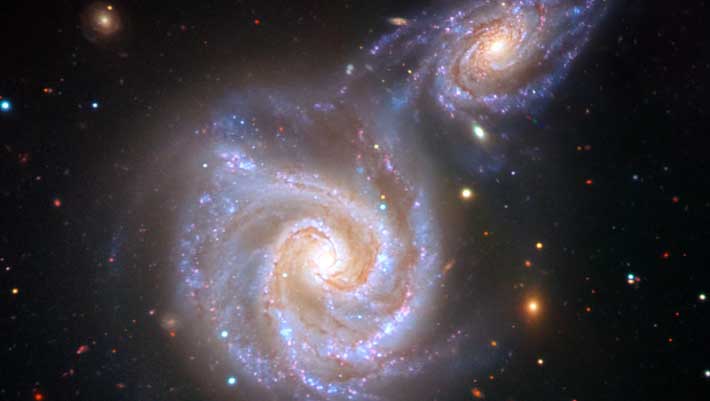
New Research Sheds Light on Formation History of Milky Way | Astronomy
Recent results based on data from ESAs Gaia mission have revealed that the stellar content of the inner halo of our Milky Way Galaxy is dominated by debris from satellite dwarf galaxies, such as the Gaia-Enceladus (also known as the Gaia Sausage). The merging event with the Gaia-Enceladus/Sausage galaxy is now purported to be one of the most important in the Milky Ways history, shaping how we observe it today. In a new analysis of data from NASAs Kepler mission as well as from the Gaia and APOGEE surveys, astronomers were able to identify the most precise ages currently possible for a sample of about a hundred red giant stars in the Milky Way; they found that our Galaxy had already formed a substantial population of its stars — which now reside mainly in its thick disk — before the collision with the Gaia-Enceladus/Sausage galaxy around 10 billion years ago.An impression of the encounter between the Milky Way and the Sausage dwarf galaxy. Image credit: V. Belokurov / Juan Carlos Muñoz / ESO.Our evidence suggests that when the merger occurred, the Milky Way had already formed a large population of its own stars, said Dr. Fiorenzo Vincenzo, an astronomer in the Center for Cosmology and Astroparticle Physics at the Ohio State University.Many of those homemade stars ended up in the thick disk in the middle of the Galaxy, while most that were captured from Gaia-Enceladus/Sausage are in the outer halo of the Galaxy.The merging event with Gaia-Enceladus/Sausage is thought to be one of the most important in the Milky Ways history, shaping how we observe it today, added Dr. Josefina Montalban, an astronomer in the School of Physics and Astronomy at the University of Birmingham.In making the calculations, the astronomers used asteroseismology data from the Kepler satellite in combination with data from the Gaia and APOGEE surveys. All three are set up to gather data to help scientists map and characterize stars in the Milky Way.Asteroseismology is a relatively new technique, which measures the relative frequencies and amplitudes of the natural modes of oscillation of the stars.This enables scientists to assemble information about the stars size and internal structure, which enables accurate estimations of the stars age to be made.In this research, the authors used information on the individual oscillation modes of each star, rather than averaged properties of their pulsations.They were also able to use asteroseimology in combination with spectroscopy — which enables the chemical composition of the stars to be measured.We have shown the huge potential of asteroseismology in combination with spectroscopy to deliver precise, accurate relative ages for individual, very old, stars, said Professor Andrea Miglio, an astronomer at the University of Bologna.Taken together, these measurements contribute to sharpen our view on the early years of our Galaxy and promise a bright future for Galactic archeoastronomy.By calculating the age of the stars, the researchers were able to determine, for the first time, that the stars captured from the Gaia-Enceladus/Sausage galaxy have similar or slightly younger ages compared to the majority of stars that were born inside the Milky Way.A violent merger between two galaxies cant help but shake things up, Dr. Vincenzo said.The results showed that the merger changed the orbits of the stars already in the Galaxy, making them more eccentric.The scientists compare the stars movements to a dance, where the stars from the former Gaia-Enceladus/Sausage move differently than those born within the Milky Way.The stars even dress differently, with stars from outside showing different chemical compositions from those born inside the Milky Way, Dr. Vincenzo said.The findings were published in the journal Nature Astronomy._____J. Montalbán et al. Chronologically dating the early assembly of the Milky Way. Nat Astron, published online May 17, 2021; doi: 10.1038/s41550-021-01347-7
……Space
Comments
Leave a comment in Nestia App